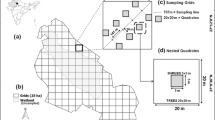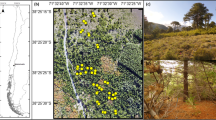Summary
Georgiades (1994) records 152 adventive species for Cyprus, out of which the following 16 species were regarded as spreading to natural habitats:Vinca major L.,Cistus ladanifer L.,Tagetes minuta L.,Tanacetum balsamita L.,Tanacetum parthenium (L.) Sch.Bip.,Corylus maxima Mill.,Iris albicans Lange,Acacia saligna (Labill.) H.Wendl.,Robinia pseudoacacia L.,Epilobium angustifolium L.,Oxalis pescaprae L.,Eschscholzia californica Cham.,Papaver somniferum L.,Dodonaea viscosa (L.) Jacq.,Antirrhinum majus L.,Vitis vinifera L. We reexamined the spreading status of these species and we found thatAcacia saligna (Labill.) H.Wendl. is the most serious invasive species on Cyprus, threatening many natural habitats, invading forests, maquis, gangue, phrygana, marshy areas and agricultural land, becoming a serious weed.Robinia pseudoacacia L. similarly toAcacia saligna, but to a less extend is spreading in forests, maquis, garigue and phrygana vegetation. Apart from the above species, we observed for the first time that the following adventive species (Georgiades, 1994) are spreading in natural habitats, namely:Celtis australis L.,Cercis siliquastrum L.,Prunus dulcis (Mill.) D.A.Webb,Ailantus altissimma (Mill.) Swingle andCasuarina cunninghamiana Miq. The spreading status ofAilanthus altissima threatens natural habitats invading forests and maquis. Further moreFraxinus angustifolia Vahl subsp.angustifolia, Pyrus malus L. andPrunus persica (L.) Batasch are new additions to the adventive flora of Cyprus, recorded for the first time. These three species are also spreading in natural habitats. Also, the problems posing to the environment and to biodiversity are discussed.
Zusammenfassung
Georgiades (1994) registrierte 152 adventive Arten für Zypern von welchen die folgenden 16 Arten sich in den natürlichen Lebensräume ausgebreitet haben:Vinca major L.,Cistus ladanifer L.,Tagetes minuta L.,Tanacetum balsamita L.,Tanacetum parthenium (L.) Sch.Bip.,Corylus maxima Mill.,Iris albicans Lange,Acacia saligna (Labill.) H. Wendl.,Robinia pseudoacacia L.,Epilobium angustifolium L.,Oxalis pes-capre L.,Eschscholzia californica Cham.,Papaver somniferum L.,Dodonea viscosa (L.) Jacq.,Antirrhinum majus L.,Vitis vinifera L. Wir untersuchten noch mal Das ausma\ der Verbreitung dieser Arten und stellten fest dass Acacia saligna (Labill.) H. Wendl.die aggressivste eingewanderte Art auf Zypern ist. Es bedroht vielerlei natürliche Lebensräume und dringt z.B., ein in Wälder, Maquis, Garigue, Phrygana (Strauch Heide), Feuchtgebiete und Agrarland wo es sich zu einem lästigen Unkraut entwickelt. ähnlich verhält sichRobinia pseudoacacia L. dass sich aber nicht so extensive in Wäldern, Maquis, Garigue und Phrygana Vegetation ausbreitet. Abgesehen von den obigen Arten beobachteten wir erstmalig dass die folgenden adventiven Arten (Georgiades, 1994) sich in natürlichen Lebensräume ausbreiteten:Celtis australis L.,Cercis siliquastrum L.,Prunus dulcis (Mill.) D.A. Webb,Ailantus altissimma (mill.) Swingle undCasurina cunninghamiana Miq. Der Ausbreitungsgrad vonAilantus altissimma bedroht die natürlichen Lebensräume Wälder und Maquis. Weiterhin sind Fraxinus angustifolia Vahl subsp.Angustifolia, Pyrus malus L., undPrumus persica L. Batasch Neuankömmlinge zur Adventivflora von Zypern. Diese 3 Arten verbreiten sich auch in den natürlichen Lebensräumen. Die Probleme dieser Adventivarten für die Umwelt und für die Biodiversität werden erörtert.
Similar content being viewed by others
References
Bovil, A.K., 1915: Report on Plantation Work in Cyprus, 1879 – 1914.
Clout, M. andLowe, S. 1997: Biodiversity loss due to biological invasion: Prevention and cure. Pages 29–40in:Clayton D., A. Rubec andG. O. Lee (Compilers) Conserving Vitality and Diversity. Proceedings of the World Conservation Congress Workshop on Alien Species. Published in Partnership with the IUCN Species Survival Commission and the North American Wetlands Conservation Council (Canada). Ottawa, Canada: Canadian Wildlife Service, Environment Canada.
Chapman, E.F. 1949 (reprinted 1967): Cyprus Trees and Shrubs. Nicosia.
Christodoulou, P., 2001: Personal communication.
Croft, P.W., 1991: Man and Beast in Chalcolithic Cyprus. Bulletin of the American Schools of Oriental Research282/283, 63–79.
Davis, S.J.M., 1984: Khirokitia and its Mammal Remains: A Neolithic Noah's Ark. Pages 147–62in: A. Le Brun, Fouilles recentes a Khirokitia (Cypre), 1977–1981. Paris: Editions Recherches sur les civilisations, ADPF, Memoire no. 41.
Davis, S.J.M., 1989: Some More Animal Remains from the Aceramic Neolithic of Cyprus. Pages 189–221in A. Le Brun, Fouilles recentes a Khirokitia (Chypre), 1983–1986. Paris: Editions Recherche sur les Civilisations, ADPF, “Memoire” no 81.
Della, A., Iatrou, G., 1995: New Plant Records from Cyprus. Kew Bulletin,50, 387–396.
Forestry Department, 1985: Flora of Cyprus — List of species ever introduced in Cyprus (up to 31.12.1984). Nicosia.
Fox, J: Review of the Ecological Characteristics of Acacia saligna (Labill.) Wendl. Mulga Research Centre Journal,12, 39–55.
Frangos, G., 1923: Cyprus Agricultural Journal18, 85.
Gass, I.A., 1980. The Troodos massif: Its role in the unravelling of the ophiolite problem and its significance in the understanding of constructive plate margin processes. Pages 23–35in Panayiotou, A. (ed.), Ophiolites. Proceedings International Ophiolite Symposium. 1979. Nicosia.
Gennadiou, P.G., 1914 (reprinted 1997): Lexikon Phytologikon (Phytological Dictionary). Athens: Ekdoseis Trochalia.
Gennadius, P., 1908: List of Indigenous or Exotic Plants Growing in the Island (Katalogos ithagenon i exotikon fyton fyomenon en Kypro). Supplement to the Cyprus Journal.
Georgiades, C., 1987: Flowers of Cyprus, vol. II, Plants of Medicine. Nicosia
Georgiades, C., 1994: “I epigenis chlorida tis Kyprou, taxinomiki, xloridiki, fytogeografiki, oikofysiologiki meleti” (The adventive flora of Cyprus, taxonomic, floristic, phytogeographic, ecophysiological study). PhD thesis. Athens University.
Greuter. W. et al., 1984–1989: Med-Checklist. Vols. 1–3. Conservatoire et Jardin Botaniques, Ville de Geneve Med-Checklist Trust of OPTIMA, Geneve.
Grey-Wilson, C., 1993: Mediterranean Wild Flowers. Harper Collins Publishers. Great Britain.
Hadjikyriakou, G., 1997: I chlorida tis Kyprou mesa apo katalogous kai pinakes (The Flora of Cyprus derived from Catalogs and Tables). Cyprus.
Hadjikyriakou, G. Ta koina onomata ton ithagenon kai xenikon fyton pou apantoun stin Kypron (Common names of the indigenous and exotic plants in Cyprus). In preparation.
Hadjisterkotis, E., 1996: Ernährungsgewohnheiten des Zyprischen MuflonsOvis gmelini ophion. (Food habits of the Cyprus mouflonOvis gmelini ophion) Z. Jagdwiss.42, 256–263.
Hadjisterkotis, E., 1999: Gefahren für das Zyprischen Muflon aufgrund des Vorkommens als einzelne Restpopulation in einem einzigen Verbreitungsgebiet. (Dangers facing the Cyprus mouflon from being one population in one reserve) Z. Jagdwiss,45, 27–34.
Hadjisterkotis, E., 2000: The introduction of wild boarSus scrofa in Cyprus: an alien species in a highly endemic area. Biogeographia vol. 20-1999 (Pubblicato il 30 glugno 2000) Biogeografia dell' Anatolia.
Hadjisterkotis, E., 2001: The Cyprus mouflon, a threaten species in a biodiversity “hotspot” area. Pages 71-81 inNahlik A. andUloth W. (eds.), Proceedings of the Third International Symposium on Mouflon, Sopron Hungury.
Hadjisterkotis, E., Bider, J.R., 1997: Cyprus. Pages 89–92in D.M. Shackleton (ed.) and the IUCN Caprinae Specialist Group. Wild Sheep and Goats and their Relatives, Status Survey and Conservation Action Plan for Caprinae. Information Press, Oxford.
Hadjisterkotis, E., Masala, B., 1995: Vertebrate extinction in Mediterranean islets: an example from Cyprus. Biogeographia18, 691–699.
Hadjisterkotis, E., Van Haaften, J.L, 1997: Die Niederwildjagd im Wald von Paphos und ihre Auswirkungen auf gefahrdete zyprische MufflonOvis gmelini ophion. (Small game hunting in the forest of Paphos and its effects on the endangered Cyprian mouflon (Ovis gmelini ophion) Z. Jagdwiss.43, 279–282.
Hadjisterkotis, E.,Masala, B.,Reese, D., 2000: The origin and extinction of the large endemic Pleistocene mammals of Cyprus. Biogeographia Anatolia.
Harland, W.B., Cox, A.V., Llewellyn, P.G., Pickton, C.A.G., Smith, A.G.,Walters, R., 1982: A geological time scale. ambridge University Press, Cambridge. 113 p.
Hobbs, R.J., Huenneke, L.F., 1992: Disturbance, diversity, and invasion: implications for conservation. Conservation Biology6, 324–337.
Holmboe, J., 1914: Studies on the Vegetation of Cyprus. Bergens Museums Skrifter. NY Raekke. Bind I. No. 2. Bergen.
Kavvada, D.S., 1956: Ikonografimenon Votanikon-Fytologikon Lexikon (Illustrated Botanical-Phytological Dictionary). Vols. 1–9. Athens.
Killion, M.J., Grant, W.E., 1995: A colony-growth model for the imported fire ant: potential geographic range of an invading species. Ecological Modeling77, 73–84.
Konstantinou, G. et al., 1997: I Geologia tis Kyprou (The Geology of Cyprus). Bulletin 10. Geological Survey Department, Ministry of Agriculture, Natural Resources and Environment, Nicosia.
Lange, R.T., Graham, C.J., 1983: Rabbits and the failure of regeneration in Australia's arid zone. Australian Journal of Ecology8, 377–831.
Mccallum, J.E., Robertson, A.H.F., 1990: Pulsed uplift of the Troodos Massif — evidence from the Plio-Pleistocene Mesaoria basin. Pages 217–29 inJ. Malpas, E.M. Moores, A. Panayiotou, andC. Xenophontos (eds.) Ophiolites, Oceanic Crustall Analogues. Proceedings of the Symposium “Troodos 1987”. Geology Survey Department, Ministry of Agriculture, Natural Resources and Environmenrt, Nicosia.
Mcneely, J., Strahm, W., 1997: IUCN and invasive species: a framework for action. Pages 3–9in:Clayton D.A. Rubec andG.O. Lee, (Compiler) Conserving Vitality and Diversity. Proceedings of the World Conservation Congress Workshop on Alien Invasive Species. Published in partnership with the IUCN Species Survival Commission and the North American Wetlands Conservation Council (Canada). Ottawa, Canada: Canadian Wildlife Service, Environment Canada.
Meikle, R.D., 1977–1985: Flora of Cyprus. Vols. 1–2. The Bentham-Moxon Trust, Royal Botanic Gardens, Kew.
Michaelides, E., 1979: Technical Consultation on Fast-Growing Plantation Broadleaved Trees for Mediterranean and Temperate Zones. Nicosia, Cyprus.
Mitrofanous, Ieromonachou, 1849: Iatrosofikon (Practical Medicine). Published from the prototype by Filaretos Priest-Monk, 1924. Index by Constantinos Myrianthopoulos. Lefkosia.
Moores, E.M., Robinson, P.T., Malpas, J., Xenophontos, C., 1984: A Model for the Origin of the Troodos Massif, Cyprus, and other Midleast Ophiolites. Geology12, 500–503.
Myers, N.R.A., Mittermeier, C.G., Mittermeier, G.A.B., Da Fonseca, Kent, J., 2000: Biodiversity hotspots for conservation priorities. Nature403, 853–858.
Official Gazette Of The Republic, No. 3049, 29/3/1996. Convention on Biological Diversity. Law No. 4(III) of 1996.
Osorio-Tafall, B.F., Seraphim, G.M., 1973: List of the Vascular Plants of Cyprus. Ministry of Agriculture and Natural Resources, Nicosia, Cyprus.
Panagiotou, A., 1986: Geologia (Geology). Megali Kypriaki Enkyklopaideia. Lefkosia: Filokypros Publications.
Panaretou, A., 1967: Kypriaki Georgiki Laografia (Cyprian Agricultural Folklore). Nicosia: Cooperative Central Bank Ltd.
Panaretou, A., 1971: I Georgia tou topou mas (The Agriculture of our Country). Ministry of Agriculture and Natural Resources, Nicosia.
Panaretou, A., 1979: I dentrolatreia apo archaiotaton chronon mechri simera (Tree Worship from Ancient Times). Forestry Association of Cyprus, Nicosia.
Panaretou, A. Dentra Gigantes tou topou mas (Gigantic Trees in Cyprus). Ministry of Agriculture and Natural Resources, Nicosia.
Pavlidis, A., 1984–1996: Megali Kypriaki Enkyklopaideia (Great Cyprian Enkyklopaideia). Vols. 1–15. Nicosia: Filokypros Publications.
Polunln, O. 1969.Flowers of Europe, a Field Guide. Oxford: Oxford University Press.
Savidge, J.A. 1987. Extinction of an island forest avifauna by and introduced snake. Ecology 68: 660–668.
Sargent, S.S., 1965: Manual of the Trees of North America. Vols. 1–2. New York: Dover Publications.
Schofield, E.K., 1989: Effects of introduced plants and animals on island vegetation: examples fro the Galapagos Archipelago. Conservation Biology3, 227–238.
Sibthorp, J., 1806 and 1813: Florae Graecae Prodromus. Vols. 1–2. London.
Townsend, C.C.,Guest, E., 1966–1985: Flora of Iraq. Vols. 2–8. Ministry of Agriculture of the Republic of Iraq.
Tutin, T.G. et al., 1981–1993: Flora Europaea. Vols. 1–4. Cambridge: Cambridge University Press.
Vitousek, P.M., 1990: Biological invasions and ecosystem processes: towards an integration of population biology and ecosystem studies. Oikos57, 7–13.
Unger, F., Kotschy, T., 1865: Die Insel Cypern. Vien: Wilhelm Braumuller.
Waithman, J.D., Sweitzer, R.A., Vuren, D.V., Drew, J.D., Brinkhaus, A.J., Gardner, I.A., Boyce, W.M., 1999: Range expansion, population sizes, and management of wild pigs in California. J. Wildl. Manage.63, 298–308.
Author information
Authors and Affiliations
Rights and permissions
About this article
Cite this article
Hadjikyriakou, G., Hadjisterkotis, E. The adventive plants of Cyprus with new records of invasive species. Zeitschrift für Jagdwissenschaft 48 (Suppl 1), 59–71 (2002). https://doi.org/10.1007/BF02192393
Issue Date:
DOI: https://doi.org/10.1007/BF02192393
Key words
- Cyprus
- alien invasive species
- adventive plants
- Acacia saligna
- Robinia pseudoacacia
- Ailanthus altissima




